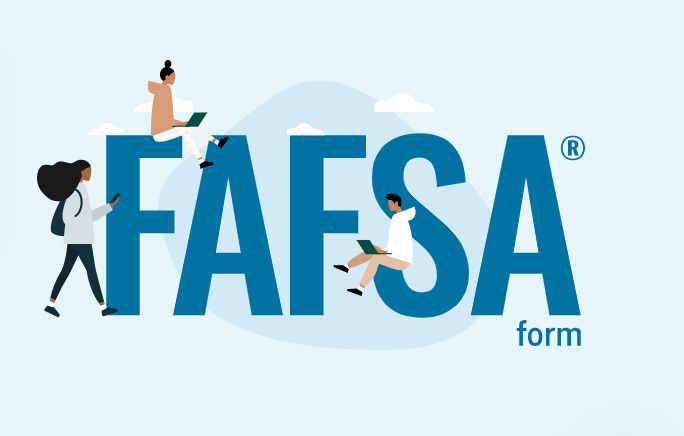This is the logo at studentaid.gov for families to complete the FAFSA application.
A crisis is unfolding in American higher education, impacting millions of American families. It doesn’t involve raging antisemitism, woke ideology run amok, or the obscene costs to attend their institutions.
The Department of Education bungled the order to “simplify” the Free Application for Federal Student Aid, known as FAFSA. This is the form parents complete for the Department of Education that determines financial awards their child receives to attend their desired college.
The agency butchered this rollout so poorly that colleges delayed award letters to students and some will be picking colleges in late spring or early summer. Its impact this fall will be worth watching. Some speculate it could throw some colleges near bankruptcy.
As FAFSA changes consume financial aid offices, colleges are demanding agency action to prevent new “gainful employment” reporting that colleges must have in place by July.
No American should be shocked that an agency formed outside constitutional authority by President Jimmy Carter could display such gross bureaucratic incompetence. The Department of Education simply did what government agencies do: use approved legislation as the opportunity for something larger, and when the agency and Congress failed to consider all aspects and potential consequences, bureaucrats insisted on an extended deadline and more money. The people most hurt were high school seniors considering college in fall 2024 and families with students already in college.
Inside Higher Ed, the Wall Street Journal, National Review, and Forbes led the charge in breaking the FAFSA fiasco and its implications.
The good news is the Department of Education cut a 100-question form to 40 questions, simplifying the form.
The bad news is the Department of Education used the bill passed in a massive December 2020 omnibus bill to update the computer system that manages FAFSA applications. Translation: the Department of Education misread their order and dove into water over their head.
This comes from the Center for Freedom and Prosperity.
Inside Higher Ed’s Katherine Knott and Liam Knox reported on the FAFSA mess:
Early on, the department decided that the most efficient way to implement the new FAFSA was to replace the decades-old central processing system, which used an outdated coding language and ran on an IBM mainframe, with a cloud-based system that would also administer some student loan programs.
(Mark) Kantrowitz, who worked on the last major changes to the FAFSA in 1996, said revamping the code system was destined to be a massive undertaking.
‘The underlying infrastructure was written in COBOL,’ he said. ‘I haven’t written code in COBOL in 40 years. That’s an ancient language, not a modern database.
A source familiar with negotiations over the FAFSA Simplification Act said those technical upgrades weren’t necessary. To fulfill the legislative mandate, the department just had to update the formula that determines how much aid a student is eligible for and redesign the form to be shorter and easier to fill out.
Americans see why policy matters. Policy affects real Americans. When the Congress and the bureaucrats fail at their jobs, it has real implications for families nationwide.
The order to simplify FAFSA emerged in late 2020 with covid consuming the nation. The Congress gave the Department of Education until Oct. 1, 2022 to complete the FAFSA simplification. The Ed Department begged Congress for an extended deadline, which was granted to Jan. 1, 2024.
While that happened, Team Biden focused on reopening schools and colleges from the pandemic. Also, President Joe Biden's top education priority was student loan amnesty, and he signed an executive order to do so. The U.S. Supreme Court overturned the executive order, but Biden has defied the court, with little criticism for doing so.
That factored into Republican demands when the agency begged for more money and an extended deadline for the FAFSA form overhaul. The GOP insisted no money could go to student debt relief.
The online FAFSA form was not available in October, as is usual. It became available in December, with the bungled rollout not being completed until sometime in January, delaying college decisions.
All of this comes with Americans losing faith in higher ed. A Gallup poll in summer 2023 revealed Americans with great or a lot of confidence in higher ed dropped from 57 percent to 36 percent between 2015 and 2023. NPR reported in January 2022 that 1 million students did not return to college following the pandemic. Meanwhile, Gen Zers see trade schools as a viable option over higher ed. It creates a weakening foundation for higher ed when greater scrutiny has emerged because of woke policies and campus antisemitism since the Hamas attack on Israel on Oct. 7, 2023.
Forbes’ Robert Farrington reported that in a typical year that 17 million FAFSA applications are submitted.
This FAFSA fiasco has damaged that tremendously. Farrington reported:
According to a February 27 Department of Education press release, more than 4.7 million families still managed to submit the FAFSA for the 2024-25 academic year by that date. That definitely sounds like a lot of students, but it falls significantly short of the 7.6 million people who filled out the FAFSA for the 2023-24 academic year by the end of February 2023. That’s a 38% drop in families filling out the FAFSA so far compared to prior years.
It’s not a stable situation for American higher education.
While we wait to see how these FAFSA changes impact students and colleges this fall, perhaps college brass and lawmakers should reflect on the mess they created.
Their grasping for solutions produce deeper complications that make college less attractive.







Good overview of the situation Curt. Do you know if they piloted the new system? If you’re going to roll out a new systems that millions of folks use, it would have made sense to do a smaller pilot program to work out the kinks.